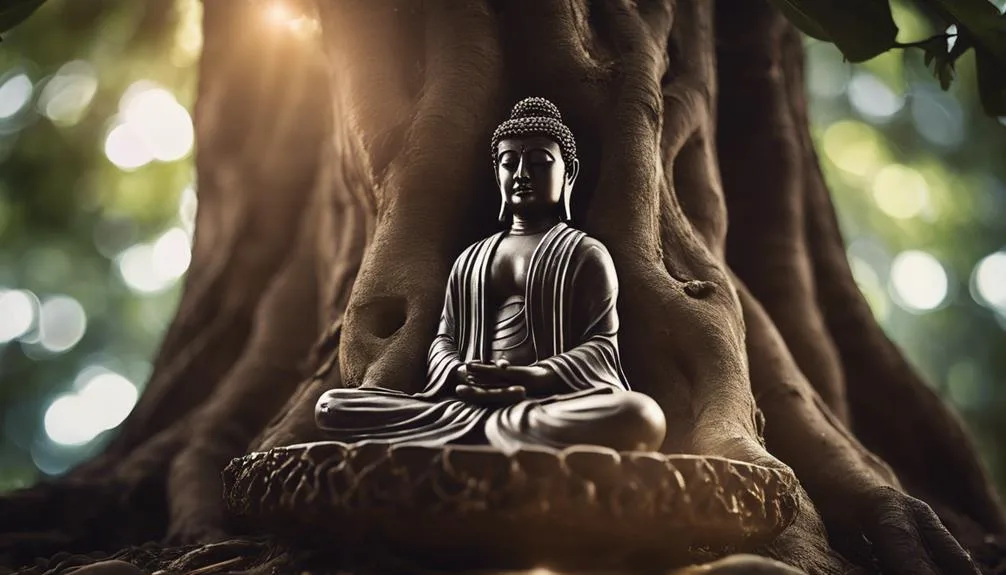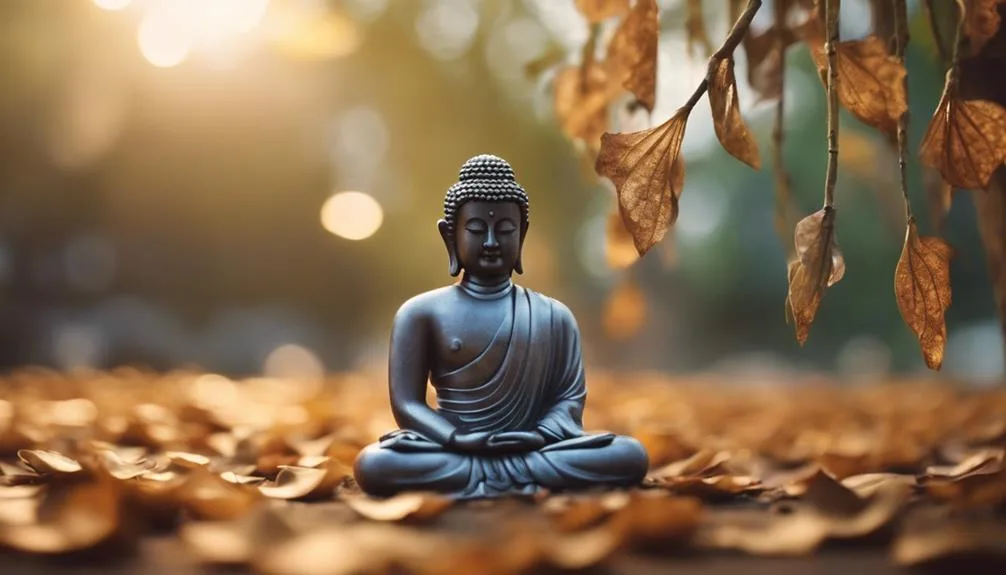Buddha's Journey: From Sheltered Prince to Enlightenment
Siddhartha Gautama's life unfolded like a lotus flower, blossoming from the muddy waters of luxury and ignorance into the radiant bloom of enlightenment. Born a prince, his journey from a life of opulence to one of spiritual awakening has captivated seekers for centuries.
The pivotal moments that led him to renounce his princely life—encounters with suffering and the realization of life's transient nature—mark the beginning of an extraordinary quest for truth. Yet, what compels a person to abandon comfort for the unknown, and what wisdom lies at the journey's end?
This tale not only invites reflection but beckons one to explore the depths of human potential and the essence of liberation.
Key Takeaways
- Siddhartha left a sheltered palace life to seek truth after encountering human suffering.
- He attained enlightenment under the Bodhi tree, overcoming obstacles and inner doubts.
- Buddha's teachings, including the Four Noble Truths, were shared for 45 years, emphasizing impermanence and the end of suffering.
- His journey from prince to enlightened Buddha inspires the pursuit of a more meaningful existence beyond worldly pleasures.
Early Life Awakening
Siddhartha's journey toward enlightenment began when he first stepped outside the palace walls, confronting the harsh realities of old age, sickness, and death. Raised in luxurious isolation, his sheltered upbringing shielded him from the suffering endemic to human existence.
This pivotal moment marked his initial step toward a profound spiritual awakening. It challenged his perception of life's impermanence and sparked a deep yearning for understanding the root causes of human suffering. Siddhartha's quest wasn't just a rebellion against his princely duties; it was a deliberate choice to seek a more meaningful existence beyond the confines of material wealth and comfort.
His early life awakening, fueled by this newfound awareness, set the stage for his transformative journey from a sheltered prince to an enlightened Buddha.
Encountering Suffering
Upon stepping outside the palace walls, he was confronted with the harsh realities of suffering, marking a pivotal moment in his journey. This encounter with old age, sickness, and death wasn't just a fleeting moment of pity; it was a profound awakening to the ubiquitous nature of suffering.
He realized that wealth and shelter couldn't provide immunity against the fundamental vulnerabilities of life. This insight led him to understand compassion at a deeper level, recognizing the universal need for empathy and kindness in a world rife with pain.
Moreover, he began embracing impermanence, seeing it not as a source of despair, but as a vital truth that could liberate one from the chains of suffering. This understanding became the bedrock of his quest, shaping his path toward enlightenment.
Quest for Truth

Driven by a deep yearning for truth, Siddhartha embarked on a quest that would challenge the very foundations of his understanding and beliefs. He left behind a life of luxury, seeking answers to life's deepest questions.
This journey wasn't just a physical one; it was a profound inner transformation. Siddhartha encountered various spiritual teachers, each offering a piece of the puzzle, yet none could quench his thirst for absolute truth.
This period of intense seeking set the stage for a remarkable spiritual awakening. It wasn't about acquiring new knowledge but shedding layers of ignorance, revealing the unadulterated truth within. Siddhartha's quest for truth underscores the universal search for meaning, emphasizing that enlightenment is a state of being that emerges from within.
Path to Enlightenment
The path to enlightenment for Siddhartha entailed a profound inner transformation, marked by the rejection of extreme ascetic practices and the pursuit of a middle way. This significant shift directed him towards a balanced approach, emphasizing meditation practice as a core element of his spiritual journey.
Through meditation, Siddhartha cultivated deep insight and awareness, facilitating his inner transformation. This practice became the cornerstone of his quest, representing not just a technique, but a way of being that transcended the physical rigors he'd previously endured.
It was in the quietude and clarity brought about by meditation that Siddhartha found the space to explore the depths of his mind, setting the foundation for his eventual enlightenment.
Overcoming Mara

Siddhartha's journey to enlightenment reached a critical juncture as he faced the daunting challenge of overcoming Mara, symbolizing the ultimate test of his resolve and spiritual insight. This confrontation wasn't just a battle against a literal foe but a profound allegory for conquering obstacles within. Siddhartha's inner resilience became his greatest weapon, demonstrating that enlightenment lies beyond the clutches of temptation and fear.
| Aspect | Significance |
|---|---|
| Mara's Challenge | Represented greed, fear, and doubt. |
| Inner Resilience | Crucial for overcoming personal and external roadblocks. |
| Conquering Obstacles | Required deep insight and unwavering determination. |
| Enlightenment | Achieved through the purification of mind and liberation from Mara's influence. |
This pivotal moment underscored the essence of Siddhartha's quest: a relentless pursuit of truth, underscored by the power of the mind to transcend its limitations.
Wisdom Sharing
Having overcome Mara's challenges, Buddha felt a profound responsibility to share his newfound insights into the nature of existence and suffering with others. He recognized the transformative potential of his teachings and embarked on a mission to enlighten individuals about the path to liberation.
Central to his wisdom sharing were mindfulness practices and meditation techniques, which he believed could cultivate awareness and alleviate the roots of suffering. By instructing followers in these practices, Buddha not only imparted knowledge but also equipped them with tools for personal transformation.
His teachings emphasized the importance of inner peace and the cultivation of a mindful existence, thereby setting the foundation for a spiritual journey toward enlightenment. Through his guidance, many found a path to transcend the cycle of suffering.
Teachings on Impermanence

Buddha's teachings on impermanence reveal life's transient nature, challenging us to confront the reality that everything is subject to change. He emphasized the importance of accepting change and engaging in impermanence contemplation to understand the true essence of life. This approach fosters a deeper comprehension of existence, urging us to appreciate the present moment without clinging to the illusory permanence of material and emotional states.
- Accepting change is vital for emotional resilience.
- Impermanence contemplation enhances mindfulness.
- Recognizing the transient nature of pleasure discourages attachment.
- Understanding impermanence fosters compassion for others.
- Acceptance of life's impermanence leads to inner peace.
Buddha's insights into impermanence illuminate the path to liberation, guiding individuals towards a life of mindfulness and compassion.
Legacy and Awakening
Reflecting on the teachings of impermanence leads us to explore the enduring legacy and the awakening that Buddha's insights continue to inspire in individuals around the world. His journey from a sheltered prince to achieving enlightenment underlines a transformative path of self-discovery and spiritual growth. The legacy impact of his teachings emphasizes the importance of mindfulness, compassion, and the pursuit of truth.
| Aspect | Influence on Individuals |
|---|---|
| Mindfulness | Enhances self-awareness |
| Compassion | Fosters empathy |
| Truth | Encourages spiritual growth |
| Legacy | Inspires global awakening |
These elements collectively play a pivotal role in guiding people towards a deeper understanding of themselves and the world around them, encouraging a journey of personal and collective awakening.
Frequently Asked Questions
How Did Siddhartha's Family Background and Early Life in the Palace Influence His Later Teachings and Philosophy?
Siddhartha's royal upbringing and luxury in the palace led to disillusionment, propelling his quest for truth. This early life experience deeply influenced his teachings on impermanence, suffering, and the path to enlightenment.
What Specific Practices or Meditations Did Siddhartha Engage in During His Search for Enlightenment That Are Not Commonly Known or Discussed?
Siddhartha engaged in lesser-known practices such as astral projection and sought cosmic consciousness during his quest for enlightenment. These methods helped him explore profound spiritual realms, contributing significantly to his path and ultimate awakening.
How Did Siddhartha's Interactions With the Common People and His Observations of Daily Life Outside the Palace Walls Shape His Understanding of Suffering and Happiness?
Siddhartha's encounters with common suffering and royal disillusionment deeply shaped his understanding. Observing life's harsh realities, he realized happiness wasn't found in palace walls, steering him towards seeking truth and a more meaningful existence.
What Were the Challenges Siddhartha Faced in Conveying His Newfound Insights to People of Different Cultures and Backgrounds During His Travels?
He faced language barriers and had to adapt rituals to resonate across cultures. These challenges symbolized his path's universality, inviting others into enlightenment despite differing backgrounds, showcasing his teachings' adaptability and inclusiveness.
How Has the Interpretation of Siddhartha's Teachings Evolved Over the Centuries, and What Are Some of the Lesser-Known Schools of Thought Within Buddhism That Emerged as a Result?
Over centuries, Siddhartha's teachings have evolved through comparative analysis, leading to modern interpretations and the rise of lesser-known Buddhist schools. These reflect diverse understandings and adaptations of his insights across cultures and time.
Conclusion
In conclusion, Buddha's transformative journey from a sheltered prince to an enlightened teacher has left an indelible mark on humanity. Today, Buddhism has grown to influence over 520 million followers worldwide, highlighting its profound impact across centuries.
Buddha's teachings on impermanence and the path to enlightenment offer timeless wisdom, encouraging mindfulness and compassion in our daily lives. His legacy continues to awaken hearts and minds, proving that enlightenment is within reach for those who earnestly seek it.






